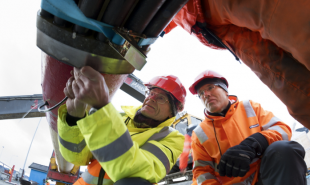
In the wake of the Gulf of Mexico oil disaster it is no surprise that oil companies are expecting environmental authorities to demand an improvement in pipeline monitoring capabilities. Luckily, Norwegian research group SINTEF’s SmartPipe project has been underway since 2006. Now, their intelligent pipelines, which can be used to monitor undersea oil pipes in between inspections, have been successfully tested at sea and in transport.
The SmartPipe comes equipped with sensors and electronics which will enable them to continually transmit real-time data about their condition to shore. The sensors, which monitor pipewall thickness, tension, temperature and vibration, are contained within belts located every 24 metres along the length of the pipeline. Electronics are concealed within a layer of polypropylene which covers the steel pipe. The pipes were recently tested in Norway’s Orkanger Harbor: 200 meters of pipeline was submerged into the seawater and, despite some sensors being destroyed, SINTEF is confident that some small modifications would remedy this and regards the tests as successful, meaning the SmartPipe project can now move into its pilot phase.
Undersea pipeline inspections currently occur every five years but the process is costly and means corrosion, fatigue development and other problems often remain unspotted for long periods. SINTEF’s research is so impressive that they have been approached by a US oil company whose own research is not as far along.
Could the underwater sensors and electronics be used to monitor other offshore ocean activity?
Website: www.sintef.no
Contact: OleOystein.Knudsen@sintef.no




